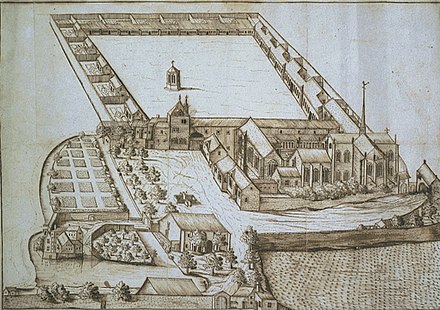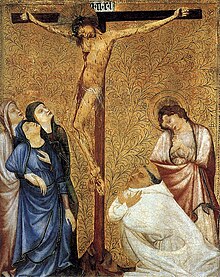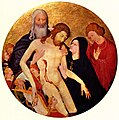Chartreuse de Champmol
The Chartreuse de Champmol is a former Carthusian monastery in Dijon in Burgundy , which was founded to become the burial place of the Dukes of Burgundy from the House of Burgundy , a branch of the Valois .

In the middle of the Moses well in a protective structure. In front right the monastery church with a pointed roof turret. On both sides of the church there are prayer rooms (oratorios) and side chapels for the duke, his wife and other donors.
To the left of the church is the somewhat lower chapter house, around the corner is the large refectory with its tracery windows. These buildings enclose the Little Cloister
Construction of the abbey
The beginnings
The construction of the Charterhouse was decided by Duke Philip the Bold , the preparatory work began in September 1377. The Duke wished to have a necropolis analogous to that of the kings of France in the basilica of Saint-Denis and chose a place near him Capital Dijon. The construction site was a few kilometers outside the city in musty terrain (hence Champmol = soft field) on the banks of the Ouche River. The project envisaged the construction of a church, a convent building, a small and a large cloister, which was to be adorned with a central fountain in the form of a calvary , a chapter house and a sacristy . The Charterhouse was dedicated to the Holy Trinity . Under the direction of Drouet de Dammartin , who had learned from Raymond du Temple , the architect of King Charles V , the excavation work began in July 1383, the ceremonial laying of the foundation stone by Duchess Margarete and her son, the twelve-year-old Johann, took place in August of the same year . The church was consecrated five years later, in May 1388, by the Bishop of Troyes , and the 24 monks moved into the monastery in October. In 1399 the wine press was finished, with the help of which the monastery started wine production.
A big construction site
The construction employed more than 250 workers and different regions and all building trades: sculptors, painters, brick makers, glaziers, joiners and foundries who were subordinate to master craftsmen. The foundrymen worked for Maître Colart, who was commissioned to make the abbey's bells. The carpenter Jean de Liège was responsible for the door frames and wall paneling; Among the brick makers, Perrin de Longchamps and Jean de Gironne are worth mentioning, with the glaziers Robert de Cambrai and Henri Glumosack. A craftsman from northern France, Jean de Beaumetz , was commissioned with the decorative work on the building , while the color scheme on the tomb of Philip the Bold goes back to Jean Malouel . Melchior Broederlam was responsible for the paintings on the altarpiece , which had been sculpted by Jacques de Baerzé in Termonde .
In 1390 the two reredos of Saints and Martyrs and the Crucifixion were commissioned from Jacques de Baerze, in 1391 they were brought to Ypres , where Melchior Broederlam took care of the paintings from 1393 to 1399. In 1399 they were installed in the Chartreuse.
The heirs of Philip the Bold
The Dukes of Burgundy provided the abbey with equipment throughout the 15th century. Henri Bellechose , Johann Ohnefurchts' court painter, worked here from 1415 to 1444 as the successor to Jean Malouel. In 1416 he was paid for an altar that was intended for the Chartreuse church, but is now in the Louvre.
The tombs
In 1384 Duke Philip the Bold commissioned his sculptor Jean de Marville to design his tomb. He employed stonemasons from Holland, among them Claus Sluter , who was appointed Maître de l'atélier in 1389, and whose work is also the portal. It is also he who realized the well of Moses and the Calvary , which was in the great cloister. When Philipp died in 1404, his tomb was not yet completed, and the new Duke Johann Ohnefurcht transferred this work to Claus Sluter, who died in 1406 after completing only two of the mourning figures. He was followed by his nephew Claus de Werve, who completed the work in 1410. Philip's wife, Duchess Margaret of Flanders, was not buried in Champmol, but in the Count's Chapel of Courtrai, the traditional burial place of the Counts of Flanders, at the side of her father Louis de Male. Duke Johann Ohnefurcht also commissioned a double tomb for himself and his wife Margarete von Bayern based on the model of his father's tomb, which only existed as a draft when he died suddenly in 1419. After Claus de Werve's death in 1439, Duke Philip the Good summoned the sculptors Jean de la Huerta (1443) and Antoine Le Moiturier (1461) to his court, who finally completed the monument in 1470 when it was installed in the Charterhouse. Duke Philip the Good died in 1467 and was buried in the Charterhouse. The execution of a tomb for him did not come about during the reign of the fourth Duke Charles the Bold (1467-77). After Charles' death in the Battle of Nancy, the Duchy of Burgundy fell back to the King of France, so that Charles no longer found his final resting place in Champmol, but after a temporary burial in Nancy was finally transferred to Bruges, where his tomb is located.
The Chartreuse de Champmol was a highly regarded building in the 16th and 17th centuries. Renovation work in the 18th century destroyed some of the medieval works that were considered old-fashioned and replaced with contemporary ones.
After the revolution
During the revolution in 1791 the monks were driven out, many of them murdered and the Chartreuse declared a national property. In 1791 Emmanuel Crétet (a later minister of Napoleon) acquired the Chartreuse from his own fortune and retired there. The entire monastery complex was demolished. Only the portal and the Moses well as well as the remains of a stair tower of the church remained. The ducal tombs were dismantled and re-erected in the church of St. Benigne in Dijon, but brutally smashed there in 1793. The chapel that stands today on the grounds of the Chartreuse is a neo-Gothic new building from the end of the 19th century.
Today the “Center hospitalier spécialisé” (CHS) Djons, a psychiatric clinic, is located on the Chartreuse site. In Dijon "aller à la Chartreuse" is a colloquial phrase for admission to the accommodation used in psychiatry.
Preserved works of art
Two larger parts of the original buildings remain in place: the Moses fountain and the portal of the chapel. The tombs of the dukes Philip the Bold and Johann Ohnefurcht, which used to be in the chapel, are now exhibited in the Musée des Beaux-Arts de Dijon . Other works of art from the Charterhouse are preserved there, in the Musée archéologique de Dijon and in other museums.
The tombs
From the small remains of the tomb of Philip the Bold and the double grave of Johann Ohnefurcht and his wife Margarethe of Bavaria, the two works were reconstructed from 1819. Only the faces and hands of the large reclining figures were preserved. According to old views, the newly worked figures were integrated. The angels sitting on the tombs and the mourning figures made of alabaster on the side walls are almost completely preserved. The marble arcades are partly reconstructed and partly old.
The portal
The portal of the chapel shows the type of iconography that is often and especially found on the Parisian retables and portals during the time of King Charles V. The kneeling donors are introduced to the Virgin by an accompanying saint; on the left Duke Philip the Bold on his knees in front of John the Baptist, on the right the Duchess Margaret of Flanders in front of Catherine of Alexandria , in the middle the Virgin Mary with the baby Jesus.
The original conception of the portal is attributed to the architect Drouet de Dammartin and the sculptor Jean de Marville, but there is evidence that Claus Sluter made changes to the original portal system. The virgin with the child, the ducal couple and the saints are from Claus Sluter.
The Well of Moses
See article Well of Moses
literature
- Michael Grandmontagne: Claus Sluter and the legibility of medieval sculpture. The portal of the Champmol Charterhouse . Wernersche Verlagsgesellschaft, Worms 2005, ISBN 978-3-88462-216-2
- Michel Huynh, Sophie Jugie, Judith Kagan: Dijon, Le puits de Moïse et la chartreuse de Champmol . ISBN 2-85822-814-0
- Renate Prochno: The Champmol Charterhouse. Burial place of the dukes of Burgundy 1364-1477. Berlin 2002.
Web links
- Ancienne chartreuse de Champmol in the Base Mérimée of the French Ministry of Culture (French)
Individual evidence
- ^ Cartel du Musée des Beaux-Arts de Dijon
- ↑ a b c d e f g h i Article sur le site du musée des Beaux-Arts de Dijon
- ↑ a b c d e Musées de Bourgogne, dossier Ducs de Bourgogne (PDF; 3.8 MB)
- ↑ Bourgogne ( Memento of the original from April 15, 2008 in the Internet Archive ) Info: The archive link was inserted automatically and has not yet been checked. Please check the original and archive link according to the instructions and then remove this notice.
- ^ Galerie et base de données internationale d'œuvres d'art
- ↑ a b c Page no longer available , search in web archives: Art médiéval, Jean de Marville, Claus Sluter
- ^ Michael Grandmontagne: Claus Sluter and the legibility of medieval sculpture. P. 69
- ^ Michael Grandmontagne: Claus Sluter and the legibility of medieval sculpture. P. 64
- ^ Michael Grandmontagne: Claus Sluter and the legibility of medieval sculpture. P. 78
Coordinates: 47 ° 19 '18.1 " N , 5 ° 1' 2.74" E










